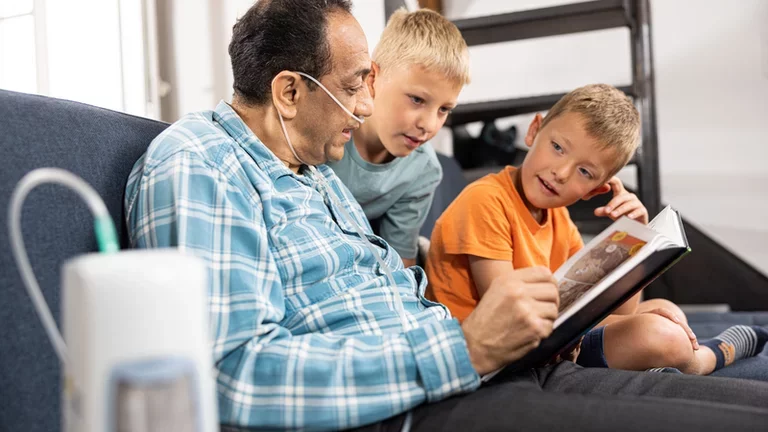Know when who needs home oxygen therapy
Everyone needs oxygen. Without it, we could not survive, as our cells use oxygen and nutrition from the food we eat to produce the energy they need to function. The air we breathe contains approximately 21% oxygen.
Home oxygen therapy
Oxygen therapy is the inhalation of oxygen-enriched air to correct hypoxemia (a lack of oxygen in the blood) when it is severe. Hypoxemia is severe when:- arterial oxygen pressure (PaO2) is less than 55 mm Hg,
- or arterial oxygen pressure (PaO2) is between 55 and 60 mm Hg and is associated with cardiac complications.
We've listed a few conditions below that can cause your body to lack oxygen and you may need "extra" oxygen to stay healthy and active.
| Chronic bronchitis | Limited airflow and inflamed airways in the lungs can produce excess mucus, causing coughing and shortness of breath. Smoking is the most common cause. |
| Emphysema | It damages the alveoli (alveoli) of the lungs. Enlarged air sacs in the lungs do not allow oxygen and carbon dioxide to enter and leave the lungs into the bloodstream. Long-term progressive disease that primarily causes shortness of breath. |
| neuromuscular conditions | A broad term that encompasses many diseases that can impair muscle function. This can interfere with your diaphragm's signals and its proper functioning, which can cause difficulty breathing. |
| Heart problems | This can interfere with the proper pumping of blood to and from the lungs, which can make breathing difficult. |
Without enough oxygen, people may find that they are limited in what they can do and that oxygen therapy gives them a better quality of life.
Chronic obstructive pulmonary disease (COPD) is the most common lung disease treated with home oxygen.
How do I get oxygen home?
VitalAire accompanies patients from the beginning of treatment, informing them about the pathology and the routine prescribed for them, familiarizing them with the equipment, giving advice on its use, maintenance and introduction of hygiene and safety standards.
- We coordinate all the preparations for your therapy from the very beginning;
- We can provide oxygen for you back from the hospital and make sure everything is ready for you when you arrive;
- We will show you and your family how to use the equipment and answer all your questions.
Our goal is to solve your concerns and make you confident with oxygen therapy.
How do I use oxygen in everyday life?
Integrating oxygen therapy into your daily routine can not only prolong your life, but also improve your quality of life. At first, you may feel self-conscious about wearing it in public, but you'll soon appreciate the benefits it brings.
The new portable oxygen systems are small and light - approximately 1.4kg. These discreet systems will help you gain confidence when you go out.
Using oxygen will help you keep doing the everyday things you enjoy.
You will soon learn to adapt to using oxygen equipment in your home, and if you have a portable unit, you can leave the house. Start with a short trip and build up to longer periods as you feel more comfortable.
How does oxygen therapy work?
There are three main types of oxygen equipment:
- Stationary oxygen concentrators ;
- Portable oxygen concentrators ;
- Oxygen cylinders.
Oxygen concentrators are electrical devices that filter the air to leave only oxygen. Portable units run on batteries. Oxygen cylinders contain oxygen under pressure to hold a larger volume of gas.
Whichever system is used, oxygen is normally delivered to the nose through soft plastic tubes (cannula). Stationary oxygen concentrators have a flexible extension tube that allows you to move around while staying connected to the oxygen supply. They provide the extra oxygen you need throughout the day.
References
2 Report of the Medical Research Council Working Party. Long-term domiciliary oxygen therapy in chronic hypoxic cor pulmonale complicating chronic bronchitis and emphysema. Lancet 1981; 1: 681-686

